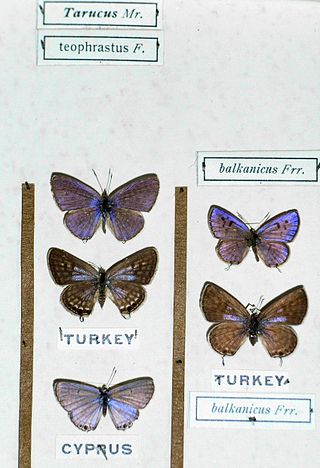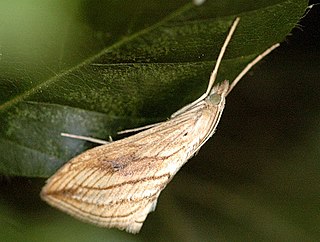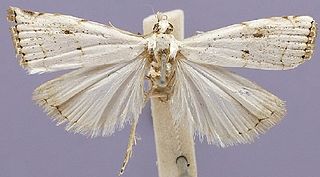
Tarucus theophrastus, the common tiger blue, pointed Pierrot or African Pierrot, is a small butterfly found in the Old World tropics. It belongs to the lycaenids or blues family.

Evergestis forficalis, the garden pebble, is a species of moth of the family Crambidae. It is found in Europe, the Palearctic and North America. The species was described by Carl Linnaeus in his 1758 10th edition of Systema Naturae

Catharylla is a genus of moths of the family Crambidae. It has Neotropical distribution from Costa Rica to southern Brazil.

Junonia iphita, the chocolate pansy or chocolate soldier, is a butterfly found in Asia.
Brenthia pleiadopa is a species of moth of the family Choreutidae first described by Edward Meyrick in 1921. It is found in Magude, Mozambique.

Catharylla bijuga is a moth of the family Crambidae described by Théo Léger and Bernard Landry in 2014. It occurs in lowlands of the Guianas and Brazil.

Catharylla chelicerata is a moth of the family Crambidae described by Théo Léger and Bernard Landry in 2014. It is found in French Guiana and Amazonas, Brazil.

Catharylla gigantea is a moth of the family Crambidae described by Théo Léger and Bernard Landry in 2014. It is found in French Guiana, Guyana and the Brazilian state of Amazonas.

Catharylla coronata is a moth of the family Crambidae described by Théo Léger and Bernard Landry in 2014. It is found in Brazil.

Catharylla serrabonita is a moth of the family Crambidae described by Théo Léger and Bernard Landry in 2014. It is found in the Brazilian states of Bahia and Espírito Santo.

Catharylla tenellus is a moth of the family Crambidae. It is found in the Atlantic Forest of Brazil in the states of Bahia, Minas Gerais, Paraná, Rio de Janeiro, and São Paulo.

Catharylla paulella is a moth of the family Crambidae described by William Schaus in 1922. It is found in Brazil and Bolivia.
Pycnarmon macrotis is a moth in the family Crambidae. It was described by Edward Meyrick in 1897. It is found in the Talaut Islands of Indonesia.
Samea antisema is a moth in the family Crambidae. It was described by Edward Meyrick in 1886. It is found on Vanuatu.
Onebala iridosoma is a moth in the family Gelechiidae. It was described by Edward Meyrick in 1918. It is found in Australia, where it has been recorded from Queensland.
Chlamydastis ophiopa is a moth of the family Depressariidae. It is found in French Guiana.
Antaeotricha himaea is a species of moth of the family Depressariidae. It is found in French Guiana.
Cerconota capnosphaera is a moth of the family Depressariidae. It is found in French Guiana.
Lecithocera cordata is a moth in the family Lecithoceridae. It was described by Edward Meyrick in 1911. It is found in southern India.
Chlamydastis crateroptila is a moth in the family Depressariidae. It was described by Edward Meyrick in 1918. It is found in French Guiana.











